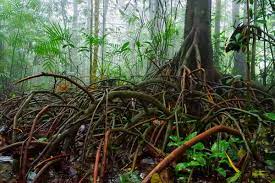Myristica Swamps : Live Fossils

The Myristica swamps, which are endemic to many species, are critically in need of conservation; currently, there is no consistent monitoring system in place to detect changes.
- Myristica swamps are called live fossils, a biodiversity hotspot dominated by evergreen trees belonging to the Myristicaceae family, one of the oldest flowering plants on earth.
- These are freshwater swamps.
- These forests are characterised by trees with large, protruding roots jutting out of waterlogged soil, which remains inundated throughout the year.
- They have evolved over millions of years and are comprised of old-growth trees.
- In India, these unique habitats occur in the Western Ghats and a smaller distribution exists in the Andaman and Nicobar Islands.
- The formation of these swamps is dependent on abiotic conditions like the shape of the valley between the forested hills, the amount of rainfall a place receives (with an average of 3000 mm), and water availability throughout the year.
- Myristica swamps are seen next to rivers and help in retaining water and act as a sponge, ensuring perennial water availability.
- These swamps are home to many vertebrate and invertebrate faunal species. This is due to stable macroecological conditions like high humidity, moderate temperature, and macrohabitat availability.




